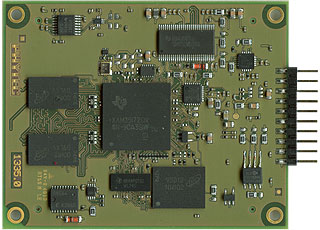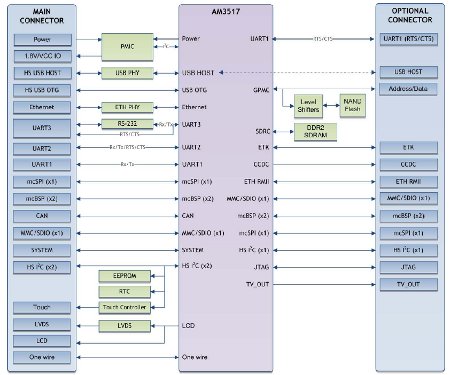Module builds on CAN-ready Cortex-A8 SoC
Feb 1, 2011 — by Eric Brown — from the LinuxDevices Archive — 6 viewsPhytec is readying a 2.8 x 2.3-inch computer module for medical and industrial-control applications, based on the Cortex-A8 Sitara AM3517 system-on-chip (SoC) from Texas Instruments. The PhyCore-AM3517 System on Module (SOM) is equipped with 256 or 512MB of DDR2 RAM and from 128MB to 512MB of flash storage, runs Linux, Android, or Windows Embedded, and has interfaces including CAN bus, 10/100 Ethernet, and USB Host/OTG, the company says.
Mainz, Germany-based Phytec offers off-shelf modules and design services in support of a variety of ARM Cortex-A8 and -A9, ARM11, ARM9, Intel Atom, and XScale devices. Its previous PhyCard-L module, for example, runs on TI's earlier Cortex-A8 OMAP3525 SoC.

Phytec PhyCore-AM3517 SOM
The AM3517 is similar to the OMAP3525's big brother, the OMAP3530, but lacks its video acceleration DSP (digital signal processor). It does, however, offer the OMAP3530's NEON SIMD co-processor and vector floating point (FP) co-processor, as well as its display subsystem, which is said to enable multiple concurrent image manipulation and support a wide variety of displays.
In addition, the AM3517 provides a Power SGX graphics 3D accelerator that supports Supports OpenGL 1.1/2.0 and OpenVG 1.0. The PhyCore-AM3517 can also be optionally purchased with TI's Sitara AM3505 SoC, which is identical to the AM3517 except for the lack of the 3D accelerator chip.
According to TI, the AM3505 and AM3517 are distinguished by their support of lower-cost DDR2 memory, instead of the LPDDR required by the OMAP35x products. The AM35x chips also add 10/100 Ethernet controllers, provide PHY (physical layer) functionality for their USB 2.0 on-the-go (OTG) interfaces, and include high-end CAN controllers.
The PhyCore-AM3517 offers interfaces for all these features, and backs up the AM3517 with 256MB to 512MB of DDR2 RAM, and 128MB to 512MB of flash, says Phytec. An SDIO/SD/MMC interface is available for flash expansion, and the module supports touchscreens and LVDS displays, says the company.

PhyCore-AM3517 block diagram
(Click to enlarge)
Features and specifications for the PhyCore-AM3517 are said to include:
- Processor — TI Sitara AM3517 @ 600MHz or optional AM3505 @ 600MHz
- Memory — 256MB DDR2; optional 512MB
- Flash — 256MB NAND; optional 128MB or 512MB NAND
- Flash expansion — SDIO/SD/MMC interface
- Display — touchscreen controller; LVDS LCD transmitter
- Networking — 1 x 10/100 Ethernet interface
- Other I/O:
- 1 x USB 2.0 High Speed Host
- 1 x USB 2.0 High Speed OTG
- 1 x CAN bus
- 4 x UARTs
- 1 x RS-232; RS-232 transceiver
- 3 x I2C
- 4 x McBSP (I2S)
- 4 x SPI
- Power — 1.8V or 3.3V input
- Dimensions — 2.83 x 2.28 inches (72 x 58mm)
- Operating temperature — -40 to 185 deg. F (-40 to 85 C)
- Operating System — Linux, Windows Embedded CE, Android
A Linux board support package BSP will be available when the PhyCore-AM3517 ships later this quarter, with the Windows Embedded BSP "coming soon," says Phytec. Support for Android is also said to be coming soon, but there is no mention of a specific BSP for Android.
The PhyCore-AM3517 is available in a Rapid Development Kit (RDK), which includes the module, a carrier board, an LCD display, and other accessories, says Phytec. No other information on the RDK is currently available, however. Phytec also offers OEM services, including embedded hardware design, Linux/Windows Embedded design development, and complete turnkey designs, says the company.
Other Linux-ready modules based on TI's AM35xx SoCs include the Lizard module from Italian embedded Linux firm Dave, Variscite's VAR-SOM-AM35 module, and CompuLab's CM-T3517. Mistral Solutions offers a 5.5 x 4.5-inch, AM3517-based CraneBoard open platform development board, which is supported by a CraneBoard.org community site and a Linux BSP (board support package).
Phytec, meanwhile, made some news in December, when ZT Systems announced an Ubuntu Linux-based R1801e 1U rackmount server based on eight of Phytec's SPEAr1310-based modules. The R1801e was claimed to be the first commercially available ARM-based development platform for the server market.
Availability
The PhyCore-AM3517 SOM will be available in the first quarter of 2011, for approximately $180 in quantities of 1000. More information may be found at Phytec's PhyCore-AM3517 page.
This article was originally published on LinuxDevices.com and has been donated to the open source community by QuinStreet Inc. Please visit LinuxToday.com for up-to-date news and articles about Linux and open source.